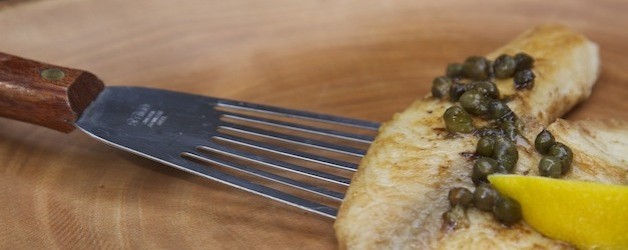

Fast Fish Fillets
All fish cooks fast. When you are looking for a quick dinner to get on the table, make fish! You don’t need to do a lot for it to taste great, although it is easy to add more flavor to cooked fish with seasonings, like a spice rub, or with a quick sauce. Since cooking methods don’t really vary with the kind of fish you select, but rather with the thickness of the fish, we’ve decided to focus on two great ways to cook thin fish fillets: broiled, and pan sautéed. Look for thin fish fillets that are between ½” – 1 ¼” thick, like tilapia, catfish, perch, orange roughy, black sea bass, and thicker flounder/sole fillets.
Broiled Fish Fillets
This is a basic recipe from Mark Bittman that is a simple, easy way to cook any type of fish. Once the broiler is heated, thin fish fillets will cook in about 2 minutes. You may need to cook in batches depending on the size of the fish and the size of your pan.
- 3 tablespoons extra virgin olive oil or melted butter
- About 1 ½ pounds thin fish fillets
- Salt and freshly ground pepper or a pinch of cayenne
- Chopped fresh parsley leaves for garnish (optional)
- Lemon wedges for serving
- Heat the broiler until quite hot. Move the rack as close to the heat source as possible. Put a sturdy pan on the rack and heat it for about 5 minutes.
- When it’s hot, remove the pan and pour in the olive oil, then put the fillets in the oil and sprinkle with salt and pepper. Time under the broiler will be 90 seconds to 2 minutes, rarely more. Do not turn; the fillets are so thin it’s not necessary. The fish is ready when it becomes opaque and the tip of a knife flakes the thickest part easily.
- To serve, carefully remove the fillets with a spatula, sprinkle with parsley if you like, and pour the pan juices over all. Garnish with lemon wedges.
Pan Sautéed Fillets
This is also a fast and simple method to cook the fish, but one that gives the fish more of a crispy texture. Although you can use panko or breadcrumbs to coat the fish, a quick dusting in flour keeps the fish moist and helps it brown. A hot pan is essential to the recipe, so make sure to let the pan preheat properly before adding the fish.
- 2 Tablespoons of butter
- 1 Tablespoon of oil
- 1 ½ pounds fish fillets, portioned into four servings
- ½ cup all-purpose flour, measured onto a plate or other shallow dish for dredging
- Salt and freshly ground pepper
- Lemon wedges
- Heat the oil and butter in a 12-inch skillet over low heat. As the pan heats up, pat the fish with paper towels to dry them off. Sprinkle with salt and pepper. Dredge in the flour, shaking off any excess.
- Increase the heat to medium-high and wait until the butter begins to brown. Add the fish, making sure not to crowd the pan. Cook, without moving the fish, for 2 to 3 minutes. If you have to work in batches, you can keep the cooked fish on a warm plate in a 200° oven. Also, if you have any pieces of fish with a tail end, you can tuck it under to create a more even thickness.
- Carefully turn the fish over with a thin spatula, and cook for another minute, until the fish just begins to flake when checked with the edge of a knife.
- Serve with lemon wedges, or with a simple pan sauce.
Flavorings and Pan Sauces
- Add a favorite spice rub to the fish before cooking to add extra flavor, especially if you have kids that may not be as used to eating fish. It is a good way to ease them into it. Something as simple as a lemon-pepper spice mix can add great flavor.
- A simple pan sauce made in the same pan immediately after cooking the fish is also a good way to vary the flavors. We love these basic guidelines for a pan sauce from Pan Anderson’s How to Cook Without a Book.
- Add a ½ cup of liquid and any flavorings (like mustard) to skillet; boil until the liquid is reduced to about ¼ cup. Tilting the skillet so that the reduced liquid is at one side of the pan, whisk in butter until the sauce is smooth and glossy.
- Here are some of our pan sauce favorites using her method: White Wine Vinegar Pan Sauce (6 Tablespoons chicken broth, 2 Tablespoons white wine vinegar, 2 Tablespoons Dijon mustard, 1 Tablespoon butter); Lemon-Caper Pan Sauce (6 Tablespoons chicken broth, 2 Tablespoons lemon juice, 2 teaspoons drained capers, 1 Tablespoon butter).
